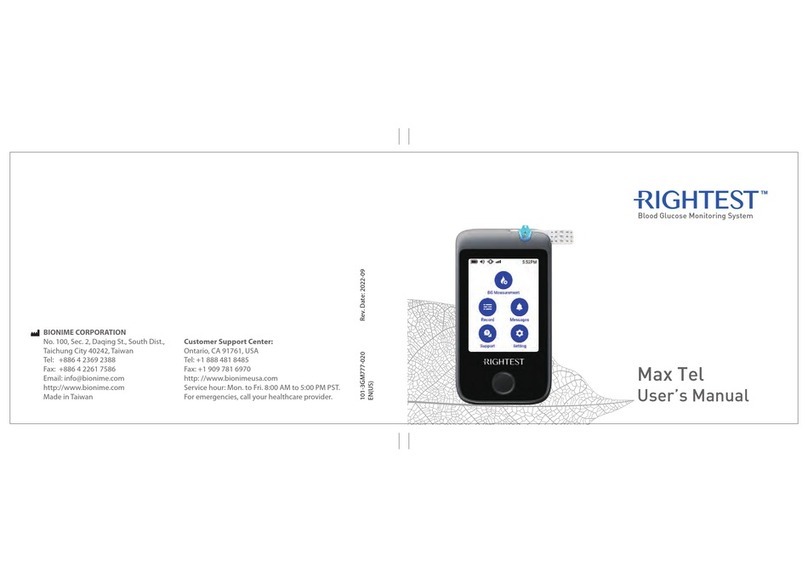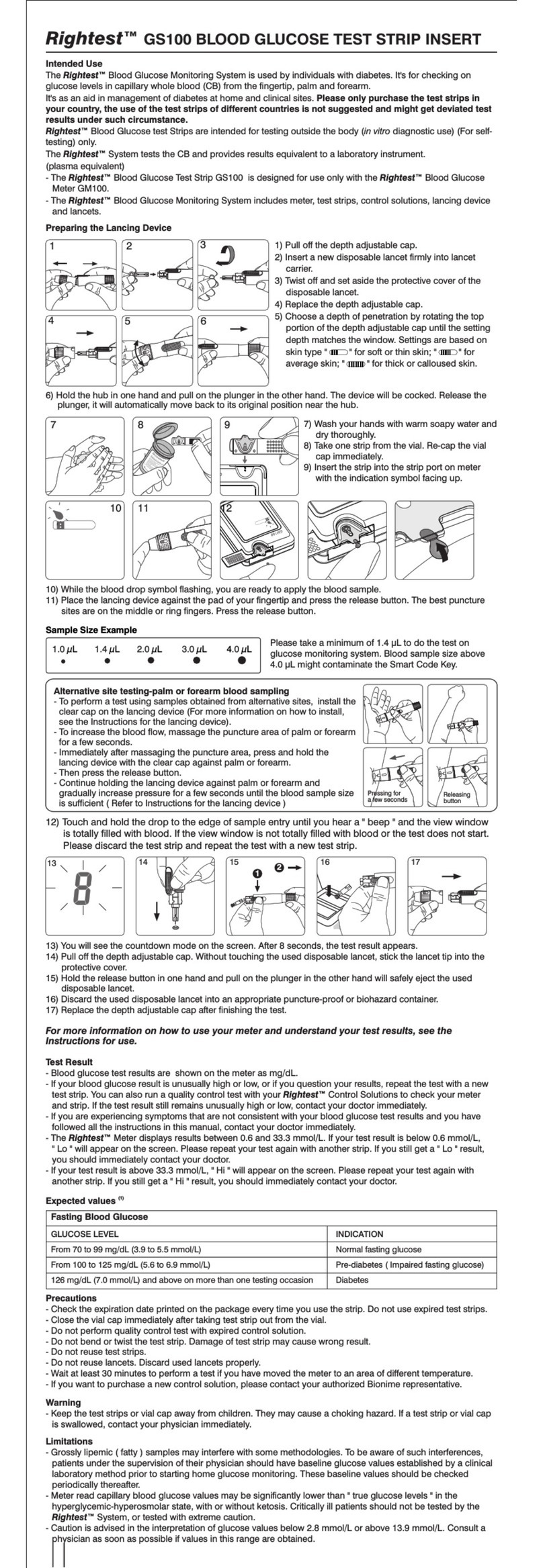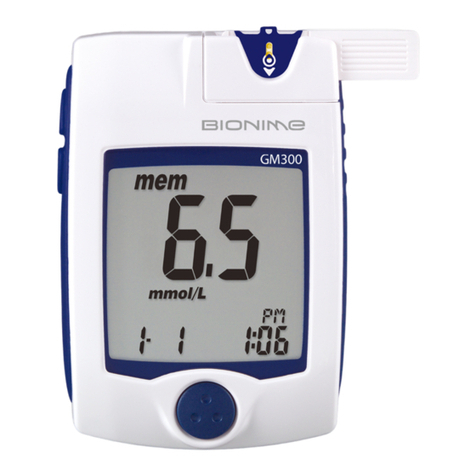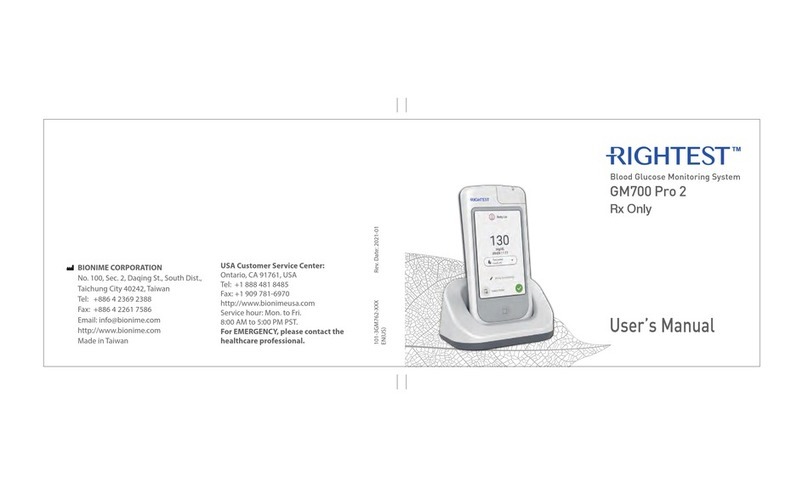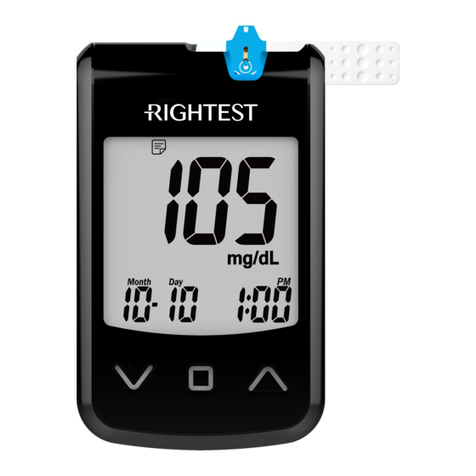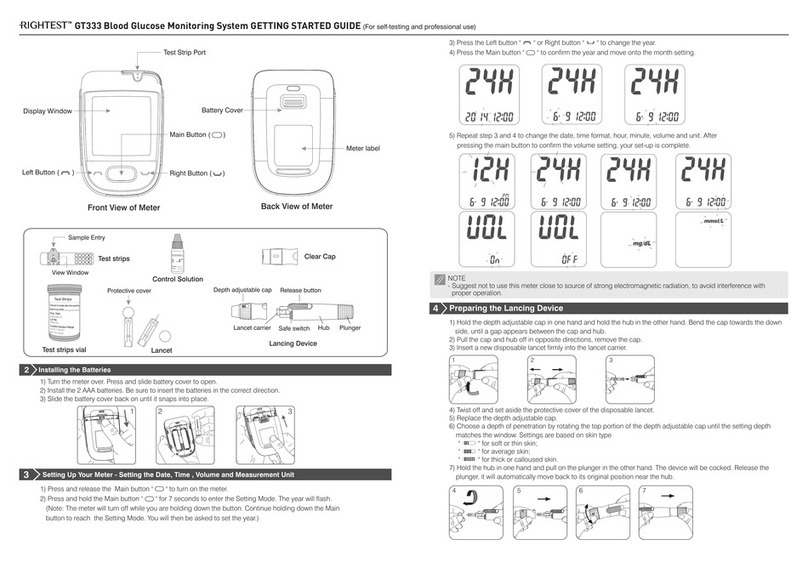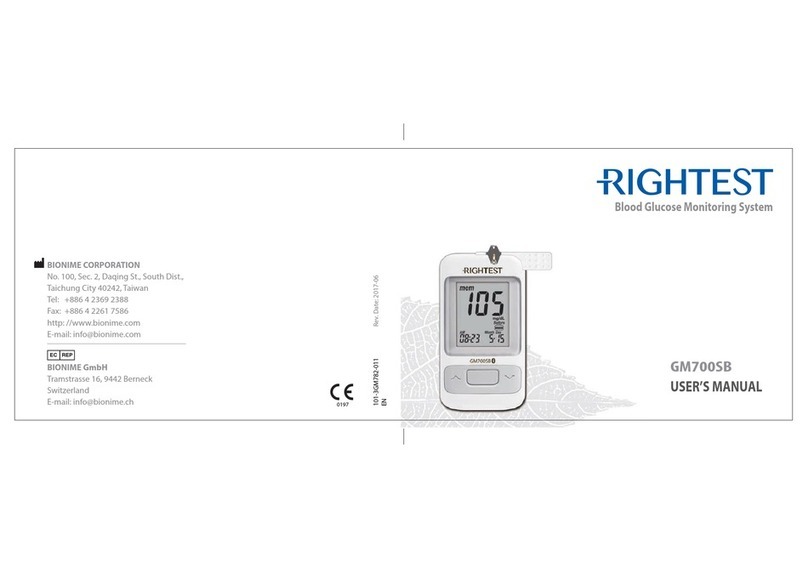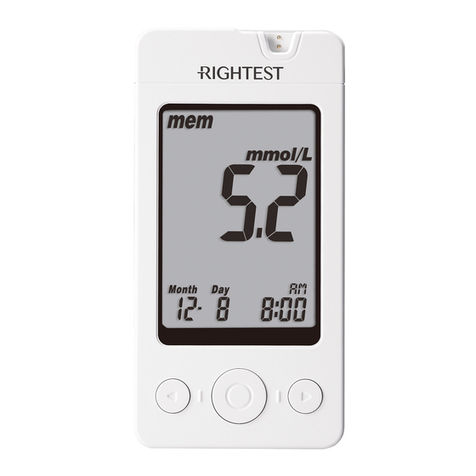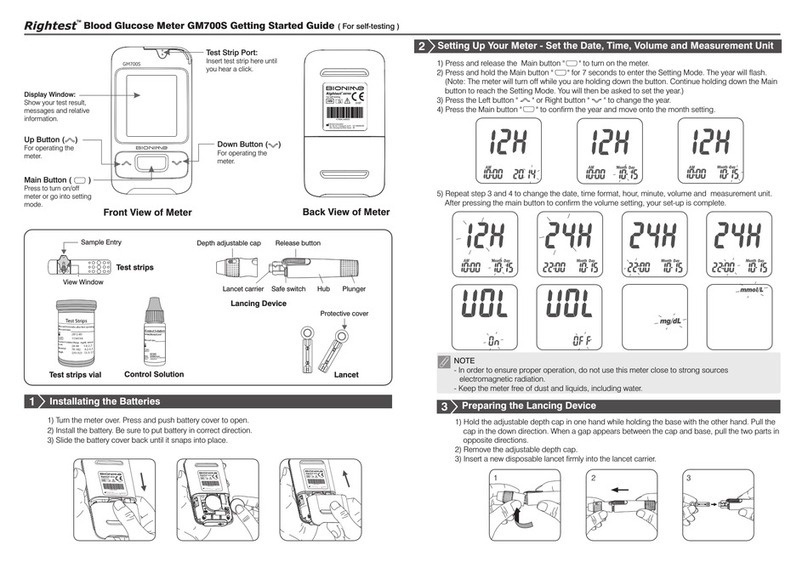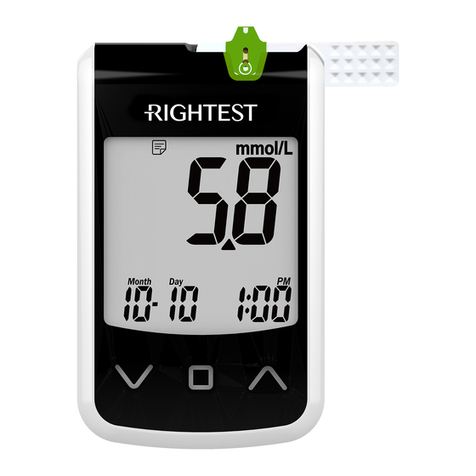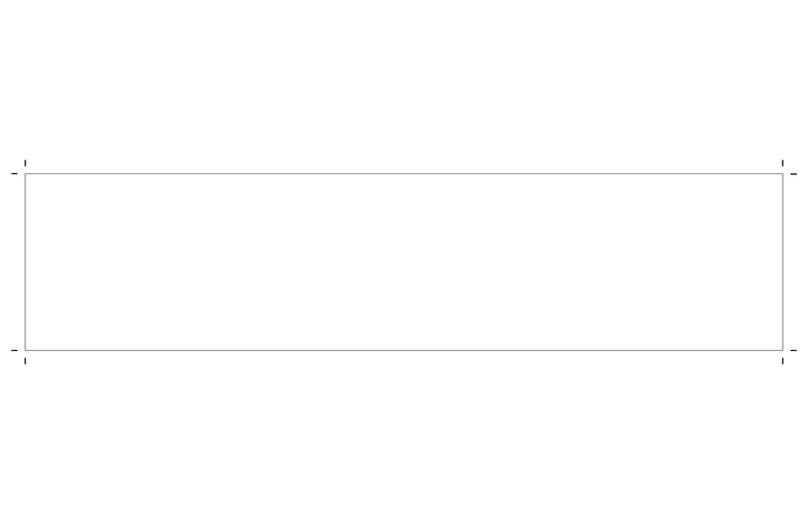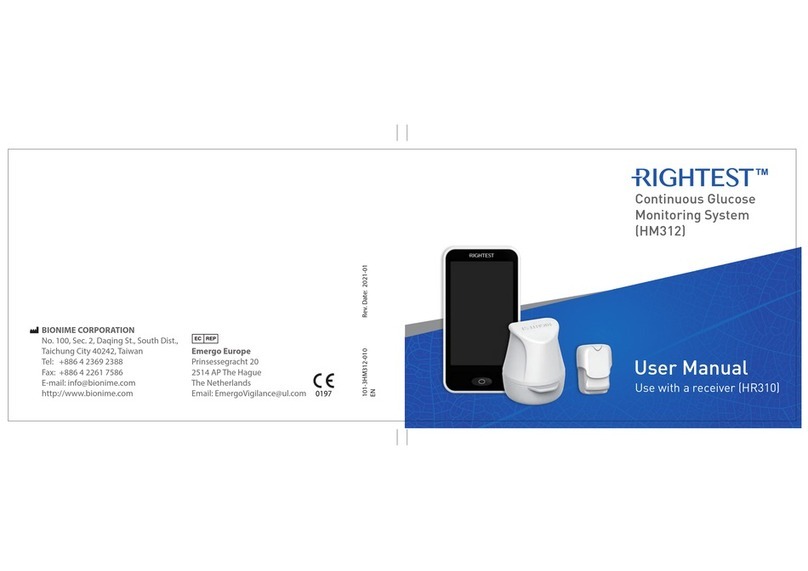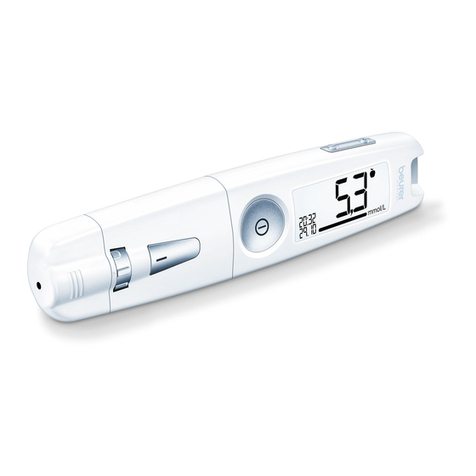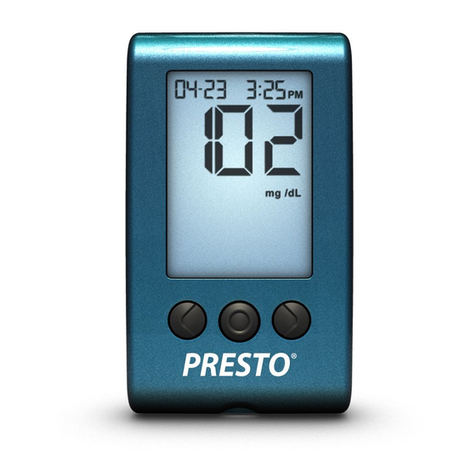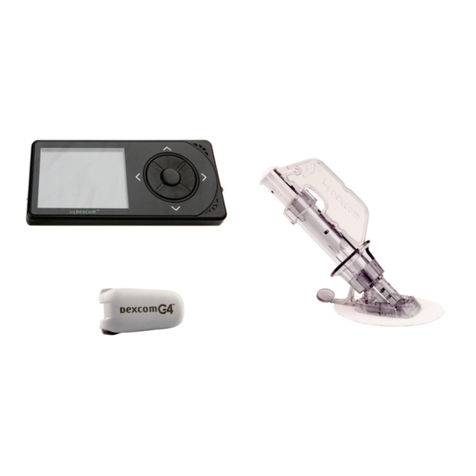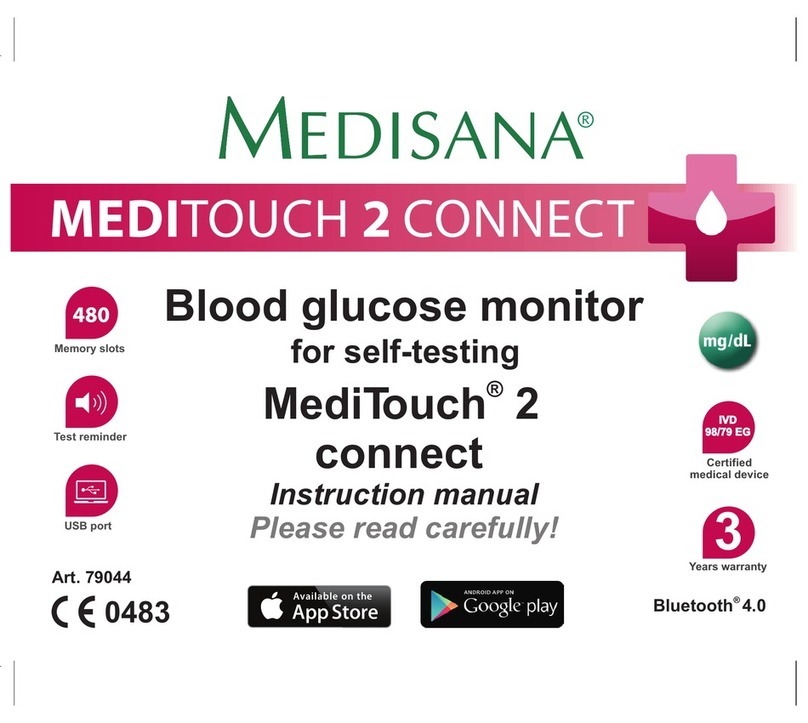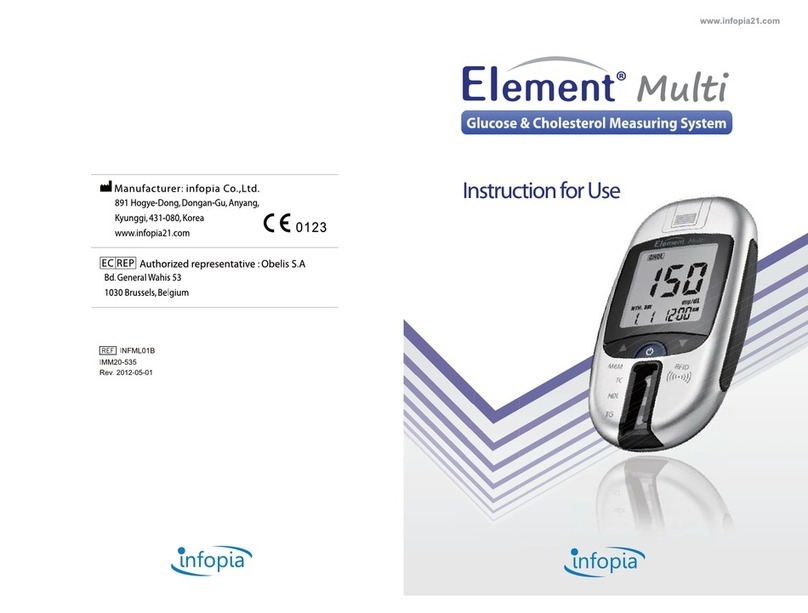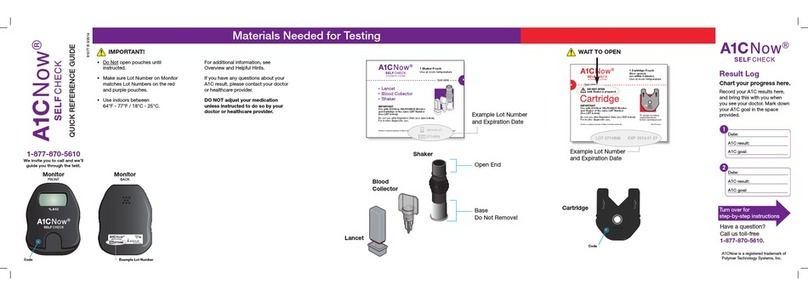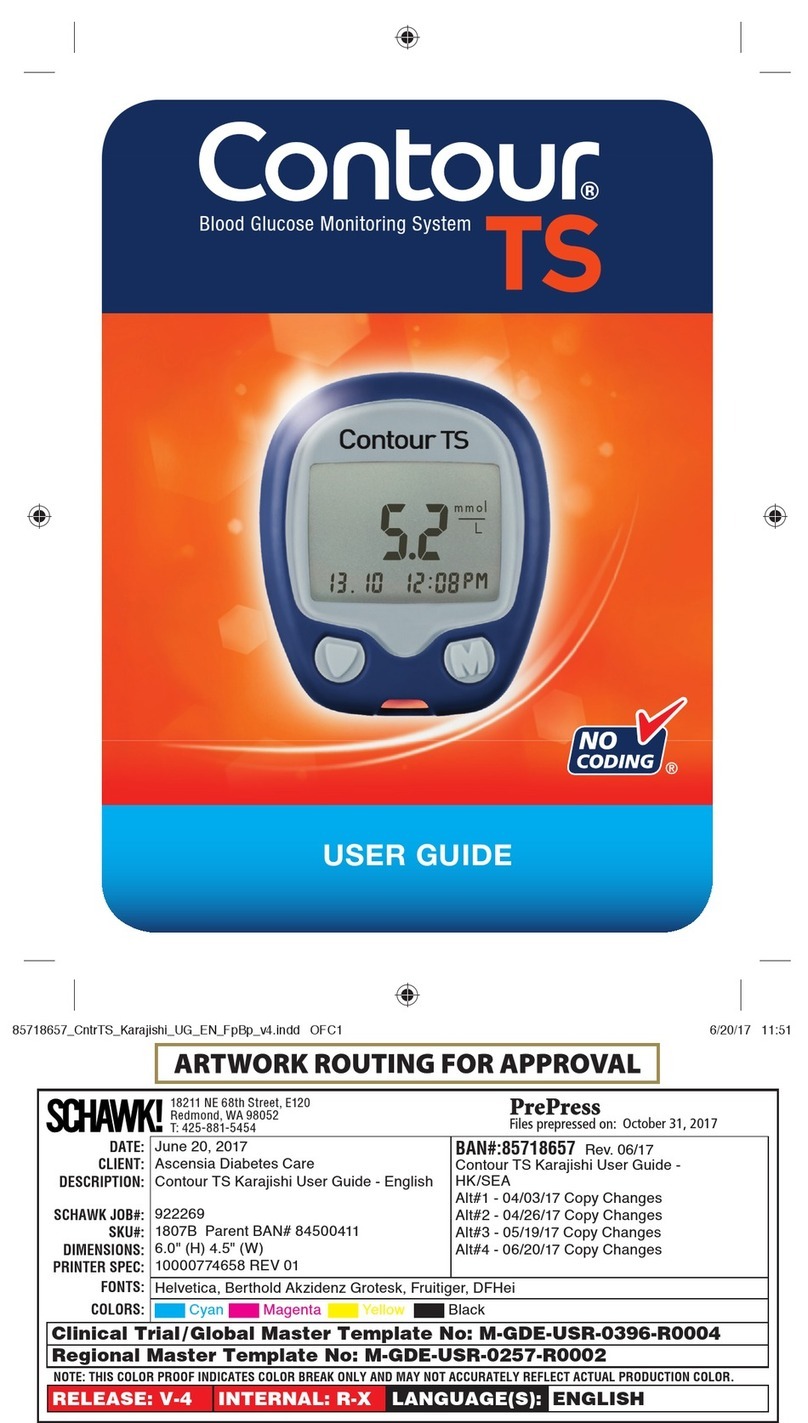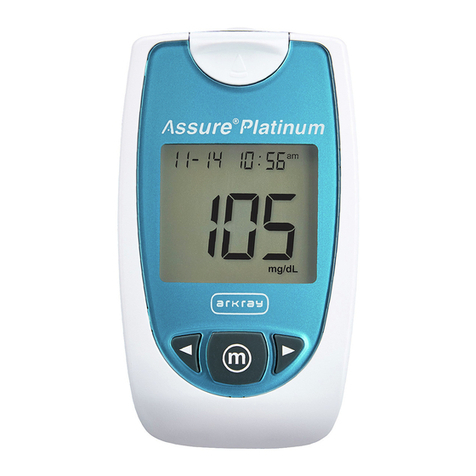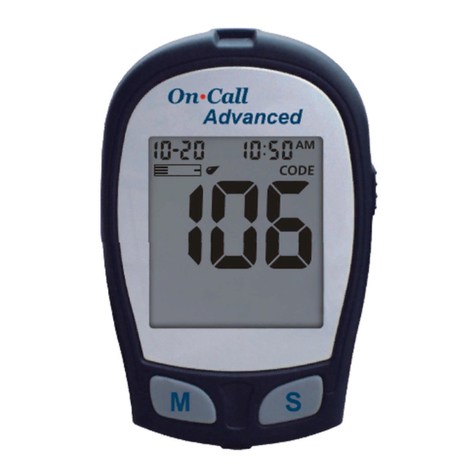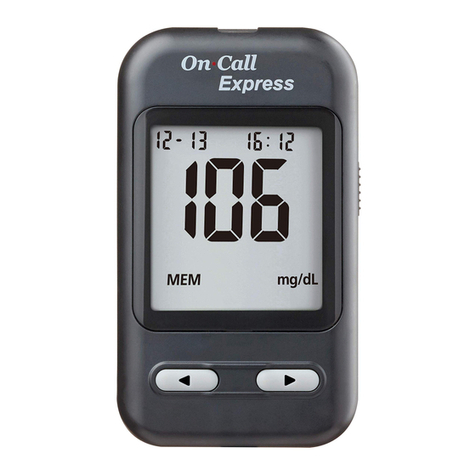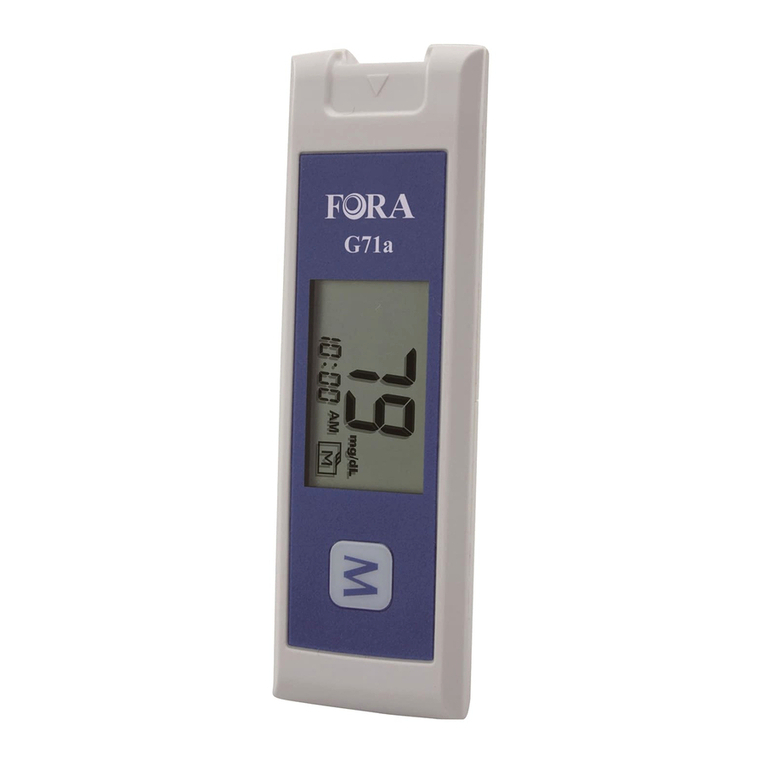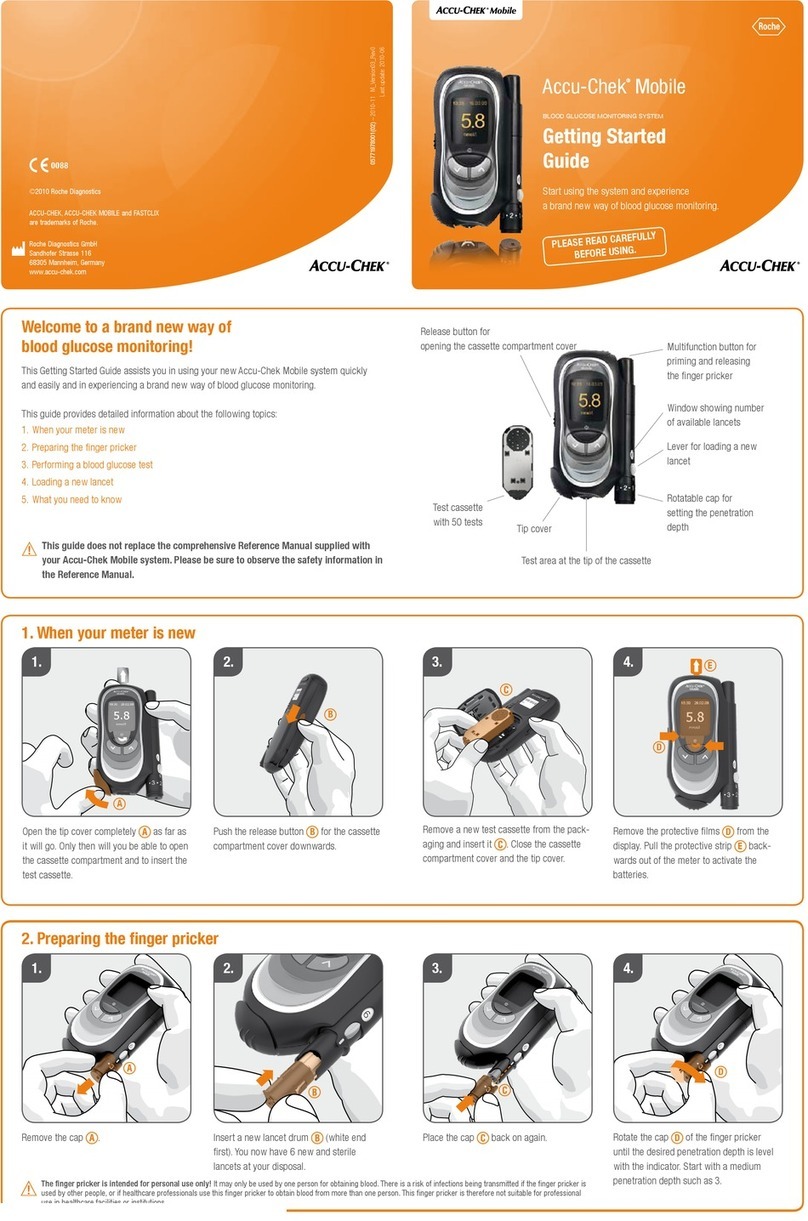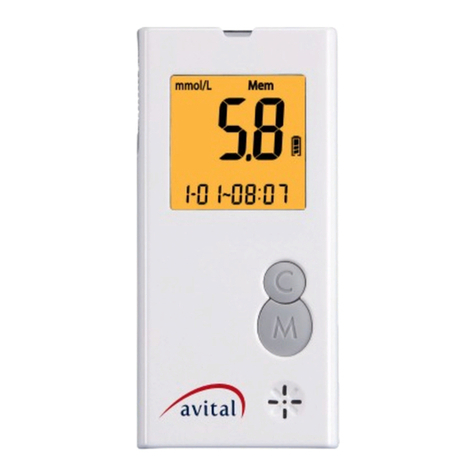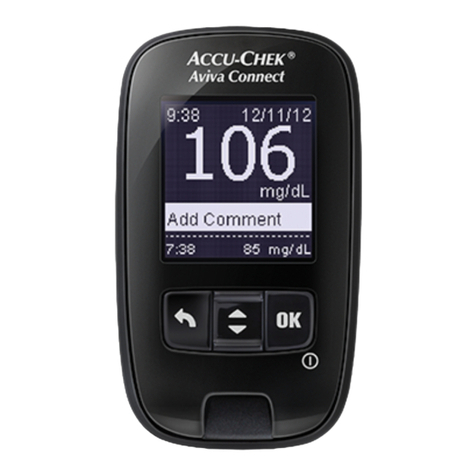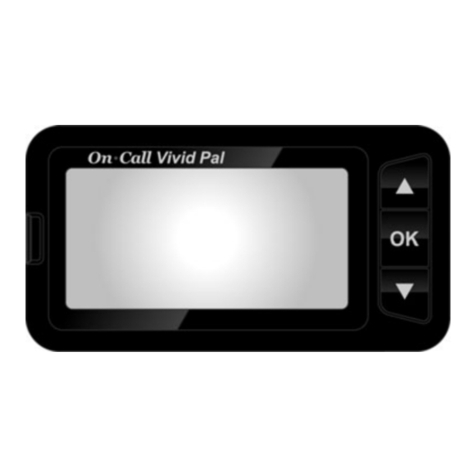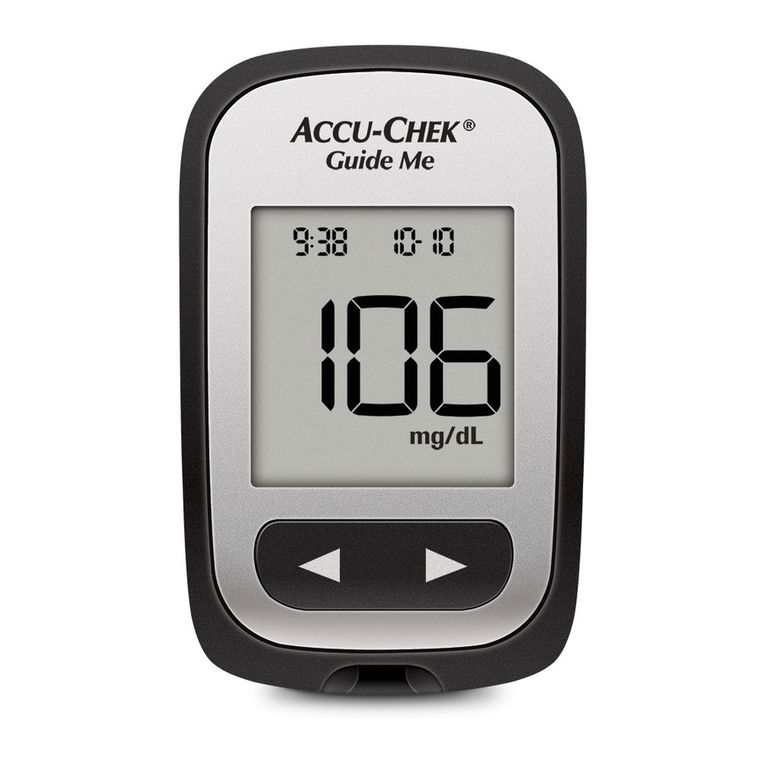
Performing a Test
1) Take one test strip from the vial. Close the vial cap immediately.
2) Insert the strip into the strip port of the meter with the sample window facing up. Push the strip in until it clicks and stops. The meter will
automatically detect the code number.
3) When the blood drop icon flashes on the display window, blood sample is ready to be applied to the test strip port (apply within 2
minutes).
4) Place the lancing device to your fingertip and press the release button.
5) Touch and hold the drop to the edge of sample entry until you hear a " beep " (if volume is turned on) and the View Window is totally
filled with blood. If the View Window is not totally filled with blood or the test does not start, please discard the test strip and repeat the
test with a new test strip.
GT333 Blood Glucose Test Strip INSERT
Intended Use
RIGHTEST GT333 Blood Glucose Test Strip is used by individuals with diabetes. It's for checking on glucose levels of whole
blood from capillary. Capillary blood can be sampled from the fingertip, palm and forearm and it provides results equivalent to
a laboratory instrument (Plasma equivalent). RIGHTEST GT333 Blood Glucose Test Strip aid to diabetes control, could be
used by healthcare professionals in clinical setting, also by people to use at home.
RIGHTEST GT333 Blood Glucose Test Strip is intended for self-testing outside the body (in vitro diagnostic use) by people with
diabetes at home as an aid to monitor the effectiveness of diabetes control. RIGHTEST GT333 Blood Glucose Test Strip
should not be used for the diagnosis of, or screening for diabetes or for neonatal use. Alternative site testing should be done
only during steady - state times (when glucose is not changing rapidly).
RIGHTEST GT333 Blood Glucose Test strip is designed for use with RIGHTEST GT300 or GT333 Blood Glucose Meter to
obtain accurate results.
Please use a minimum blood drop size of 0.75 to perform µL
the test on glucose monitoring system. Blood drop sizes
greater than 3.0 are too large and may contaminate the test µL
strip port of the meter.
Sample Size Example
Alternate site testing: palm or forearm blood sampling
- To perform a test using samples obtained from alternative sites, install the
clear cap on the lancing device (For more information on how to install,
see the Instructions for the lancing device).
- To increase the blood flow, massage the puncture area of palm or
forearm for a few seconds.
- Immediately after massaging the puncture area, press and hold the
lancing device with the clear cap against palm or forearm.
- Then press the release button.
- Continue holding the lancing device against palm or forearm and
gradually increase pressure for a few seconds until the blood sample size
is sufficient ( Refer to Instructions for the lancing device ).
0.75 µL 1.0 µL µL µL 3µL 1.5 2.0 .0
6) Touch and hold the drop to the edge of sample port until you hear a " beep " (if volume is turned on) and the sample
window is completely filled with blood. If the view window is not completely filled with blood the test will not start. If this is
the case, discard the test strip and repeat the test with a new test strip.
7) The countdown mode will begin on the display window. After 5 seconds your test result will appear.
8) Remove the test strip from the meter. Please follow your local regulations to properly discard the used strip.
9) To remove the lancet, pull off the depth adjustable cap of the lancing device. Without touching the used disposable lancet,
insert the lancet tip into the protective cover. Hold the release button of the lancing device in one hand and pull on the
plunger with the other hand to safely eject the used disposable lancet into an appropriate puncture-proof or biohazard
container.
For more information on how to use your meter and understand your test results, see the User’s Manual.
6
7
8
Precautions
- Check the expiration date printed on the test strip vial. Do not use expired test strips.
- Close the test strip vial immediately after taking test strip out from the vial.
- Do not perform a control solution test with expired control solution.
- Do not bend or twist the test strip. A damaged test strip may cause incorrect test results.
- Do not reuse test strips and lancets.
- Discard the used disposable lancet and strip into an appropriate puncture-proof or biohazard container.
- If RIGHTEST Meter and Test Strips is exposed to a significant change in temperature, please wait at least 45 minutes before
performing a test.
- If you want to purchase new control solutions, please contact Customer Service.
- Test results may vary if blood samples are taken from different sites or under certain conditions where glucose levels can
change rapidly such as: following a drink, a meal, an insulin dose or exercise. In these cases, only the fingertip should be
used.
- Users should wash their hands thoroughly with soap and water after handling the meter, lancing device, control solution and
test strips.
Test Result
- Blood glucose test results are shown on the meter as mg/dL or mmol/L, depending on the preset of your meter.
- If your blood glucose result is unusually high or low, or if you question your results, repeat the test with a new test strip. You
can also run a Quality Control Test with the RIGHTEST Control Solution GC570 to check your meter and test strip. If the test
result still remains unusually high or low, contact your Physician or the nearest Emergency Healthcare Services immediately.
- If you are experiencing symptoms that are not consistent with your blood glucose test results and you have followed all the
instructions in this insert, contact your Physician or the nearest Emergency Healthcare Services immediately.
- RIGHTEST Meter display results between 10 and 600 mg/dL. If your test result is below 10 mg/dL,
" Lo " will appear on the screen. Please repeat your test with a new strip. If you still get a " Lo " result, you should immediately
contact your Physician or the nearest Emergency Healthcare Services.
- If your test result is above 600 mg/dL, " Hi " will appear on the screen. Please repeat your test with a new strip. If you still get
a " Hi " result, you should immediately contact your Physician or the nearest Emergency Healthcare Services.
(1)
Expected glucose values without diabetes
Releasing
button
Limitations
- The meter readings of the blood glucose may be significantly lower than " true glucose levels " in a hyperglycemic-
hyperosmolar state, with or without ketosis.
- Caution is advised when glucose values in the interpretation of glucose values are below 50 mg/dL or above 250 mg/dL .
Consult a Physician as soon as possible, if values in this range are obtained.
- Healthcare professionals should evaluate their technique and their patients' technique regarding the use of RIGHTEST
Blood Glucose Monitoring System regularly . To accomplish this, it is recommended that blood glucose monitoring results
be compared with a concurrently obtained laboratory measurement on the same blood sample. A proven clinical
laboratory method employing hexokinase or glucose oxidase should be used as the comparative method.
- Hands and fingers contaminated with sugar from foods or beverages may cause falsely elevated results.
- Flouoride should not be used as a preservative when collecting blood glucose samples.
- Storage of strips near bleach as well as bleach containing products will affect the results of RIGHTEST Blood Glucose T est
strip.
- Inaccurate test results may be obtained at altitudes greater than 10,000 feet (3,048 meters) above sea level.
- Severe dehydration and excessive water loss may cause inaccurately low results.
- Do not perform the blood glucose test at temperatures below 10°C (50°F) or above 40°C (104°F), nor below 10% or above
90% relative humidity.The suggested temperature range for the control solution test is 15 - 40 °C (59 - 104 °F).
- RIGHTEST Blood Glucose Test strip are designed for use with capillary whole blood samples. Do not use serum or plasma
samples.
Warning
- Keep the test strips and vial cap away from children; they may cause a choking hazard. If a test strip or vial cap is swallowed,
contact your Physician immediately.
- Please refer to the cleaning and disinfecting instructions in the User's Manual.
Preparing the Lancing Device
Wash your hands with warm soapy water and dry thoroughly before you start the test.
1) Hold the depth adjustable cap in one hand and hold the hub in the other hand. Bend the cap towards the down side, until a
gap appears between the cap and hub.
2) Pull the cap and hub off in opposite directions, remove the cap.
3) Insert a new disposable lancet firmly into lancet carrier .
4) Twist off and set aside the protective cover of the disposable lancet.
5) Replace the depth adjustable cap.
6) The adjustable cap with 7 depth levels allows you to select the depth of penetration by rotating the cap until the preferable
depth display in the window. Settings are based on skin type " " for soft or thin skin; " " for average skin;
" " for thick or calloused skin.
7) Hold the hub in one hand and pull on the plunger in the other hand. The device will be cocked. Release the plunger, it will
automatically move back to its original position near the hub.
Test Procedure
GLUCOSE LEVEL
From 70 to 99 mg/dL (3.9 to 5.5 mmol/L)
From 100 to 125 mg/dL (5.6 to 6.9 mmol/L)
126 mg/dL (7.0 mmol/L) and above on more than one testing occasion
INDICATION
Normal fasting glucose
Pre-diabetes (Impaired fasting glucose)
Diabetes
Fasting Blood Glucose
7654
3
1 2
2
4
5
3
9
12
Pressing for
a few seconds
Forearm
Palm
1
TM
Rotate
